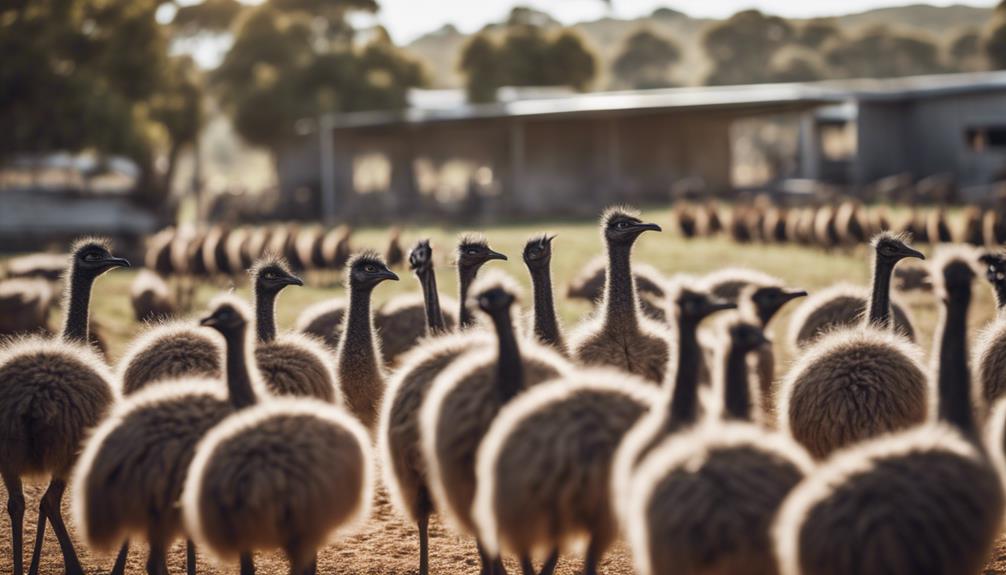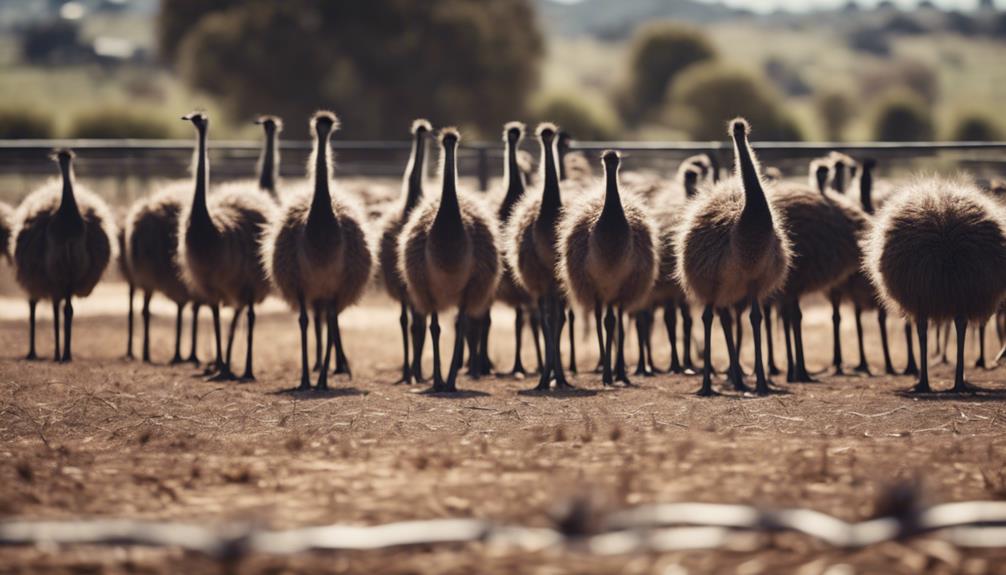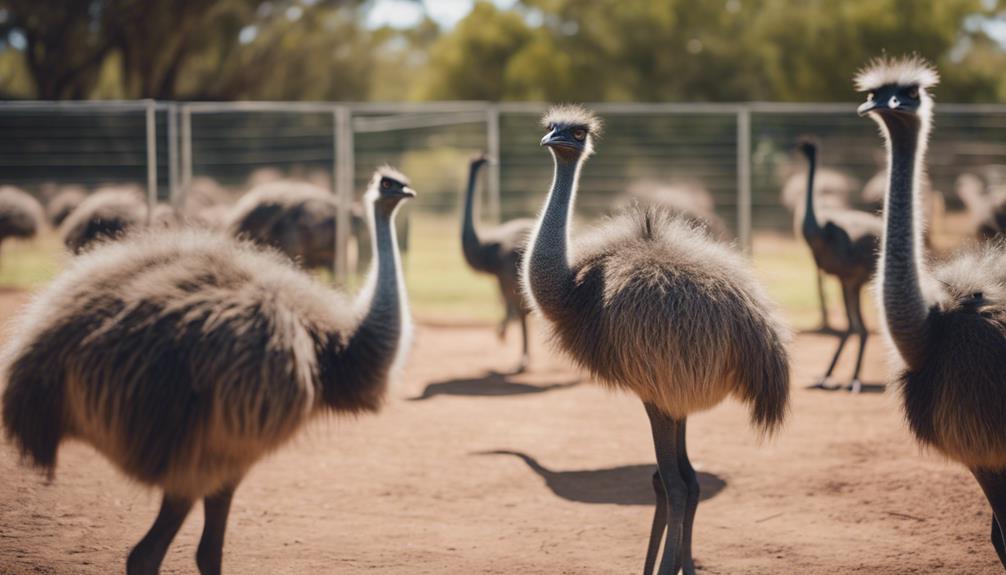
When it comes to maximizing profit in emu farming, think of it as a puzzle with various pieces that need careful consideration to fit together seamlessly. You have the potential to unlock significant financial gains by optimizing feeding practices, enhancing breeding techniques, and ensuring top-notch health management for your emus. But what about the lesser-known strategies that could potentially revolutionize your emu farming business? Stay tuned to discover the secret ingredients that could take your profits to the next level and set your emu farm apart from the rest.
Key Takeaways
- Implement strategic feeding practices to meet emus' nutritional requirements efficiently.
- Focus on selective breeding for superior genetics and diversity to enhance profitability.
- Prioritize health management, vaccination, and preventive care for optimal productivity.
- Utilize cost-effective housing solutions to reduce operational expenses and maximize profits.
- Explore diversification opportunities and risk management strategies for sustainable profitability.
Emu Farming Basics

To succeed in emu farming, understanding the fundamental principles of raising and managing these unique birds is crucial. Emus are large flightless birds native to Australia, known for their lean meat, oil, and feathers. When starting an emu farm, it's essential to consider factors such as suitable habitat, proper fencing, and adequate nutrition. Emus require a spacious area to roam, as they're highly active birds that need room to exercise and forage.
Furthermore, investing in quality fencing is paramount to prevent emus from escaping and to protect them from predators. Emus are naturally curious creatures and can be prone to wandering if not contained properly. Additionally, ensuring a balanced diet for emus is vital for their overall health and growth. Emus are omnivores and should be fed a diet that includes a mix of grains, fruits, vegetables, and insects.
Strategic Feeding Practices
Implementing a strategic feeding regime is pivotal for maximizing profit and ensuring optimal growth in emu farming. To achieve this, it's essential to formulate a balanced diet tailored to meet the specific nutritional needs of emus at different stages of growth. Emus require a diet rich in protein for muscle development, along with adequate amounts of vitamins and minerals for overall health and productivity. Feed formulations should be based on scientific research and adjusted based on the growth stage of the emus to optimize feed efficiency.
Monitoring feed consumption and adjusting rations accordingly is crucial in maximizing profit. By keeping detailed records of feed intake and growth rates, farmers can identify trends and make informed decisions to optimize feeding practices. Additionally, investing in high-quality feed sources may initially seem costly but can lead to significant long-term gains in terms of improved growth rates and overall health of the emus. Strategic feeding practices not only contribute to maximizing profit but also play a key role in ensuring the success and sustainability of an emu farming operation.
Breeding for Profit

Maximize your profit potential in emu farming by strategically focusing on breeding for optimal results. The key to maximizing profit through breeding lies in selecting superior breeding stock. Evaluate potential breeders based on desirable traits such as size, fertility, and temperament. Conduct thorough research on bloodlines and genetic history to ensure the best possible outcomes.
Implement a breeding program that emphasizes genetic diversity to enhance the overall health and vigor of your emu flock. Avoid inbreeding by introducing new genetic material regularly. Consider factors such as age, health, and past breeding performance when selecting breeding pairs to increase the chances of producing quality offspring.
Track and analyze breeding data to identify successful pairings and replicate them for future breeding cycles. Monitor the growth and development of offspring to assess their potential for profitability in the market. By prioritizing strategic breeding practices, you can position your emu farming operation for maximum profitability and success.
Health and Wellness Management
Strategically managing the health and wellness of your emu flock is crucial for maximizing profitability in your farming operation. Healthy emus are more productive, leading to higher quality products and increased profits. Regular health check-ups, vaccination schedules, and a well-balanced diet are essential components of maintaining optimal health in your emu flock.
To ensure peak performance, monitor the overall health of your emus closely. Keep detailed records of each bird's health history and any treatments administered. This data-driven approach allows you to identify patterns, detect potential health issues early, and take proactive measures to prevent widespread outbreaks that could impact your bottom line.
Investing in preventative healthcare measures may require an initial outlay, but the long-term benefits far outweigh the costs. Remember, a healthy emu is a productive emu, and prioritizing their well-being will ultimately lead to increased profitability in your emu farming venture.
Cost-Effective Housing Solutions

Ensuring cost-effective housing solutions for your emu flock is a key factor in optimizing operational expenses and maximizing profitability in your emu farming business. When considering housing options for your emus, it's essential to focus on durability, functionality, and efficiency.
Utilizing prefabricated shelters can be a cost-effective solution that provides adequate protection for your flock while minimizing construction costs. These shelters should be well-ventilated to ensure proper air circulation, reducing the risk of respiratory issues among your emus.
Additionally, implementing a rotational grazing system can help decrease the need for expensive housing structures by allowing your emus access to fresh pasture regularly. This not only cuts down on feed costs but also promotes healthier, more active emus.
Investing in fencing that's sturdy and predator-proof is crucial to safeguard your flock and reduce potential losses.
Marketing Your Emu Products
To enhance profitability and expand market reach in your emu farming venture, a strategic approach to marketing your emu products is essential. Understanding your target audience is paramount. Identify potential buyers such as exotic meat restaurants, petting zoos, or cosmetic companies looking for emu oil.
Conduct market research to determine demand and pricing trends. Highlight the unique selling points of your products, whether it's the lean and healthy emu meat, luxurious emu oil, or distinctive feathers. Utilize online platforms to reach a wider audience, create a professional website, and leverage social media for promotion.
Consider attending trade shows or local fairs to showcase your products and network with potential buyers. Collaborate with retailers or distributors to expand your market presence. Offering promotions or discounts can attract new customers and encourage repeat business.
Implementing Efficient Record-Keeping

Maximizing profit in emu farming involves establishing efficient record-keeping practices to track key metrics and optimize decision-making processes. Keeping detailed records of expenses, revenues, breeding data, and health records is crucial for identifying areas of improvement and making informed strategic decisions. By maintaining accurate records, you can analyze trends, identify cost-saving opportunities, and measure the profitability of different aspects of your emu farming operation.
Efficient record-keeping allows you to track the performance of individual emus, monitor breeding outcomes, and evaluate the success of your marketing strategies. By recording data on feed consumption, growth rates, and egg production, you can identify high-performing emus and breeding pairs, enabling you to make informed decisions on which animals to keep for breeding or sale.
Moreover, maintaining comprehensive health records can help you detect and address potential issues early, reducing the risk of disease outbreaks and costly treatments. By leveraging data-driven insights from your records, you can optimize your operational efficiency, minimize waste, and maximize profitability in your emu farming business.
Emu Egg Incubation Techniques
Implementing effective emu egg incubation techniques is essential for maximizing hatch rates and ensuring the health of the chicks. To achieve optimal results, maintaining a consistent temperature of around 97 to 98 degrees Fahrenheit in the incubator is crucial. Humidity levels should be kept between 25-50% for the first 25 days, then increased to 50-60% for the final days before hatching. Turning the eggs at least three times a day is vital to prevent the embryo from sticking to the shell and to promote even heat distribution.
Monitoring the development progress through candling is recommended, discarding any non-viable eggs early on to prevent contamination. It's important to remember that cleanliness is paramount during this process to prevent the spread of bacteria. Investing in a reliable egg-turning device can streamline operations and increase efficiency. By following these meticulous incubation procedures, you can significantly increase the chances of a successful hatch, contributing to the overall profitability of your emu farming venture.
Maximizing Emu By-Products

Efficient utilization of emu by-products is crucial for enhancing profitability in your emu farming operation. Emus provide a range of valuable by-products that can significantly contribute to your bottom line. Emu oil, known for its anti-inflammatory and moisturizing properties, is a high-value product sought after in the cosmetic and pharmaceutical industries. By carefully extracting and refining emu oil from the fat deposits of your emus, you can tap into a lucrative market segment.
Additionally, emu feathers are another valuable by-product that can be used in various industries such as fashion, arts and crafts, and even as fishing lures. Properly collecting and sorting these feathers can generate additional revenue streams for your emu farm.
Furthermore, emu meat is a lean, healthy protein source gaining popularity among consumers. By diversifying your product offerings to include emu meat, you can cater to a broader market and maximize the value extracted from each bird. Strategically marketing these by-products can boost your overall profitability and establish your emu farm as a powerful player in the industry.
Emu Farm Diversification Strategies
How can diversifying your emu farm's products and services enhance your overall profitability and market presence?
Diversification is a strategic approach that can significantly boost your emu farm's revenue streams and mitigate risks. By expanding your product line to include items such as emu oil-based cosmetics, emu feather crafts, or even emu meat-based pet treats, you can tap into new market segments and cater to a wider range of customer preferences. Offering services like agrotourism experiences, educational workshops on emu farming, or consulting for aspiring emu farmers can create additional income streams.
Data shows that emu farms that have diversified their offerings experience increased customer loyalty, higher brand recognition, and improved financial stability. Strategic partnerships with local businesses for distribution or co-branding can further enhance your market reach. Overall, diversification not only strengthens your farm's resilience to market fluctuations but also positions you as a leader in the emu farming industry.
Emu Farm Risk Management

Diversifying your emu farm's products and services not only boosts revenue but also plays a pivotal role in mitigating risks, setting the stage to delve into Emu Farm Risk Management.
When it comes to risk management in emu farming, a strategic approach is essential. Conducting a thorough risk assessment is the first step. Identify potential threats such as disease outbreaks, market fluctuations, or natural disasters that could impact your farm's operations. Once risks are identified, develop a comprehensive risk management plan that outlines preventive measures and contingency plans.
Utilizing data analytics can also strengthen your risk management strategy. By analyzing market trends, production data, and financial metrics, you can make informed decisions to minimize potential risks. Additionally, consider diversifying your revenue streams further to spread risk across different products or services.
Implementing robust biosecurity measures, investing in insurance coverage, and staying informed about industry regulations are also crucial aspects of managing risks effectively in emu farming.
Sustainable Emu Farming Practices
Implementing sustainable practices in emu farming requires a holistic approach that integrates environmental stewardship with operational efficiency and animal welfare. To achieve sustainable emu farming, strategic measures such as optimizing feed formulations to minimize waste, implementing rotational grazing practices to preserve pasture health, and investing in energy-efficient infrastructure are crucial. Data-driven decision-making plays a pivotal role in monitoring resource usage, animal health, and overall farm productivity.
Strategically managing water resources, reducing carbon footprint through efficient waste management, and promoting biodiversity on the farm are essential components of sustainable emu farming practices. By analyzing key performance indicators related to sustainability, such as water usage per bird or carbon emissions per unit of emu meat produced, you can identify areas for improvement and optimize resource utilization.
Embracing sustainable emu farming practices not only benefits the environment and animal welfare but also enhances operational efficiency and long-term profitability. By integrating sustainability into your farm management strategies, you can position your emu farming business for success in an increasingly conscious market.
Frequently Asked Questions
How Can I Protect My Emus From Predators on the Farm?
To protect your emus from predators on the farm, implement strategic measures like installing secure fencing, utilizing guard animals, setting up motion-activated lights, and implementing sound deterrents. These proactive steps will safeguard your emus and maximize your profits.
What Are the Best Practices for Emu Parasite Prevention?
To effectively prevent emu parasites, implement a strict biosecurity protocol, rotate pastures regularly, and administer preventive medications. Remember, a single emu can consume up to 2.5kg of food per day, making cost-effective parasite prevention crucial for profitability.
Is There a Recommended Age to Start Breeding Emus for Profit?
To maximize profit in emu farming, consider starting breeding at 2-3 years. This age ensures maturity for successful reproduction and minimizes risks associated with breeding too early. Strategic planning around optimal breeding age can lead to enhanced profitability.
How Do I Source Cost-Effective Emu Feed Supplements?
To source cost-effective emu feed supplements, analyze suppliers for quality and pricing. Develop strategic partnerships for bulk discounts. Utilize data on nutritional content to ensure maximum benefit. Implement a structured approach to purchasing for optimal profit margins.
Are There Regulations for Transporting Emus for Sale or Slaughter?
Ensure compliance with transport regulations for emus by consulting local authorities and studying relevant laws. Implement efficient and humane transportation practices to maintain quality and meet legal requirements, ensuring smooth sales or slaughter processes.
Conclusion
You've laid the groundwork for a successful emu farming operation. By implementing strategic feeding practices, focusing on selective breeding, and prioritizing health management, you've set the stage for increased profitability.
But the real excitement lies in the potential for growth and diversification. Embrace the challenge of maximizing emu by-products, exploring new market opportunities, and fine-tuning your risk management strategies.
Your journey to sustainable emu farming success is just beginning. Keep pushing forward, the possibilities are endless.




